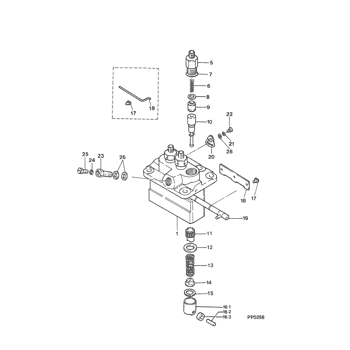Rating:
Information pump assy, injecti Denso
Compare Prices: .
As an associate, we earn commssions on qualifying purchases through the links below
DoraKvi Fuel Injection Pump 15321-51010 094500-0612 Compatible for Kubota L225 L235 L245 L275 L295DT L2050DT 0945000612 1532151010
DoraKvi 🌟 Part Name :Fuel Injection Pump || 🌟 Part Number :15321-51010 094500-0612 0945000612 1532151010 || 🌟 Application : Compatible with Kubota L225 L235 L245 L275 L295DT L2050DT || ✅ Accurate ✅- In Order To Avoid Unnecessary Returnplease. Please follow the old part number and machine model to find the right product, if you are not sure, please contact us, we are more than happy to provide services. || 💠 Reliable performance 💠- our products have been carefully designed and tested, with high reliability and stability, can maintain good working condition for a long time.
DoraKvi 🌟 Part Name :Fuel Injection Pump || 🌟 Part Number :15321-51010 094500-0612 0945000612 1532151010 || 🌟 Application : Compatible with Kubota L225 L235 L245 L275 L295DT L2050DT || ✅ Accurate ✅- In Order To Avoid Unnecessary Returnplease. Please follow the old part number and machine model to find the right product, if you are not sure, please contact us, we are more than happy to provide services. || 💠 Reliable performance 💠- our products have been carefully designed and tested, with high reliability and stability, can maintain good working condition for a long time.
094500-0612 0945000612 Fuel Injection Pump For Kubota D1100 Engine
GENERIC Part Number: 094500-0612 0945000612 || Product Name: Fuel Injection Pump || Compatible with Kubota D1100 Engine
GENERIC Part Number: 094500-0612 0945000612 || Product Name: Fuel Injection Pump || Compatible with Kubota D1100 Engine
Include in ##:
Cross reference number
Part num
Firm num
Firm
Name
09450-00612
15321-5101
PUMP ASSY, INJECTI
Information:
Obtain Oil Sample Every 250 Hour Interval (T & TA) or Every 500 Hour Interval (NA).Obtain S O S samples at regularly scheduled intervals to monitor the condition and maintenance requirements of your engine. Each oil sample should be taken when the oil is warm and well mixed to ensure that the sample is representative of the oil in the engine crankcase.Consult your Caterpillar dealer for complete information and assistance in establishing an S O S analysis program for your engine(s).S O S Analysis
S O S analysis is composed of three basic tests: * Wear Analysis* Chemical and Physical Tests* Oil Condition Analysis Wear analysis is performed with an atomic absorption spectrophotometer to monitor component wear by identifying and measuring concentrations, in parts per million, of wear elements present in the oil. Based on known normal concentration data, maximum limits of wear elements are established. Impending failures can be identified when test results deviate from concentration levels established as acceptable, based on normal wear. Chemical and physical tests detect the presence of water, fuel and glycol (antifreeze) in the oil and determine whether or not their concentrations exceed established maximum limits. Oil condition is evaluated with infrared analysis. This test determines the presence and measures the amount of contaminants such as soot, sulfur products, oxidation, and nitration products in the oil. Infrared analysis can also assist in customizing (reducing, maintaining or extending) oil change intervals for particular conditions and applications.Infrared analysis should always be accompanied by wear element analysis and chemical and physical tests to assure accurate diagnosis. Infrared analysis must be used to determine oil change intervals. S O S analysis must include Infrared (IR) in the analysis.The test results of the oil samples will then be used as a basis for determining the oil change interval for your engine, giving you the ultimate time between oil changes without the risk of engine damage.Refer to Caterpillar pamphlet Listen To Your Oil (PEDP1129) for information and benefits of S O S analysis.
S O S analysis is composed of three basic tests: * Wear Analysis* Chemical and Physical Tests* Oil Condition Analysis Wear analysis is performed with an atomic absorption spectrophotometer to monitor component wear by identifying and measuring concentrations, in parts per million, of wear elements present in the oil. Based on known normal concentration data, maximum limits of wear elements are established. Impending failures can be identified when test results deviate from concentration levels established as acceptable, based on normal wear. Chemical and physical tests detect the presence of water, fuel and glycol (antifreeze) in the oil and determine whether or not their concentrations exceed established maximum limits. Oil condition is evaluated with infrared analysis. This test determines the presence and measures the amount of contaminants such as soot, sulfur products, oxidation, and nitration products in the oil. Infrared analysis can also assist in customizing (reducing, maintaining or extending) oil change intervals for particular conditions and applications.Infrared analysis should always be accompanied by wear element analysis and chemical and physical tests to assure accurate diagnosis. Infrared analysis must be used to determine oil change intervals. S O S analysis must include Infrared (IR) in the analysis.The test results of the oil samples will then be used as a basis for determining the oil change interval for your engine, giving you the ultimate time between oil changes without the risk of engine damage.Refer to Caterpillar pamphlet Listen To Your Oil (PEDP1129) for information and benefits of S O S analysis.




